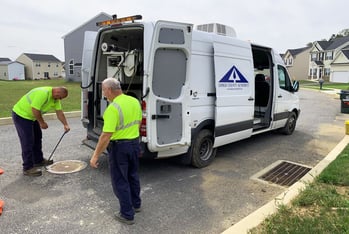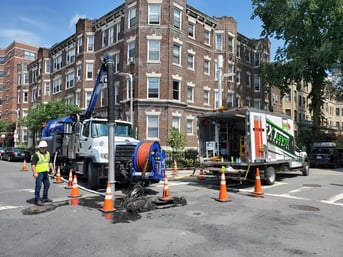Sewer systems require regular inspections and maintenance to ensure they function at peak efficiency. But who is actually responsible for the labor involved in sewer upkeep?

First and foremost, sewer systems are the property of the municipality they reside in. While the sewage may originate from a private household and flow out to mains via residentially-owned plumbing systems, the vast majority of wastewater infrastructure is buried under public land, meaning the responsibility of maintaining it likely falls to the local municipality. However, in some cases, public infrastructure is purchased and privatized, taking the burden of maintenance off of the municipality.
When we think about who is actually out there inspecting, cleaning and repairing sewer infrastructure, there are several aspects to consider, and not all of them lean on municipal utilities to get the job done. Often, a municipality’s budget, staffing constraints, infrastructure layout and overall workload are determining factors in how a sewer system is maintained, as well as who conducts that maintenance.
Utilities vs Contractors
Most commonly, the personnel conducting sewer maintenance is either an employee of the municipality to which the system belongs or a contractor hired by the municipality. Some small cities loan their infrastructure to a larger municipality or sewer authority to gain economies of scale. Others who opt to manage their own infrastructure, but don’t have the funding to hire their own wastewater professionals, may turn to utility contractors. This is also true for municipalities that simply don’t have enough infrastructure to justify having a team on the payroll.
Every municipality is different, but when it comes down to it, sewers are either maintained by the municipality itself, a private operator or by an entity (usually a contractor) that either has selected for the job.
Maintenance Team Structure
Sewer maintenance teams are often broken down into three parts: supervisors who oversee scheduling of work, maintenance of equipment and facilities; operators who work in the field; and engineers who work in the office. Supervisors ensure the operators have a plan and that everything they need for a job is in working order. While operators do the hands-on maintenance, the engineers conduct analysis of inspection data and determine where maintenance work needs to be done next.

- Supervisors - Keeping the team organized and on-schedule is the responsibility of a supervisor. These individuals oversee scheduling of work, ensure equipment and facilities are properly maintained, and coordinate with other team members to keep the department running smoothly and efficiently.
- Operators - Tasked with running jetting and camera trucks, operators are responsible for on-site maintenance. During inspections, this is the team that uses crawlers, push cameras, pole cameras, and other inspection devices to collect data that can be used by engineers to determine criticality for more targeted maintenance planning, such as jetting, root cutting, or relining. These are often crews of two or three, but some larger cities may have as many as five operators per job site.
- Engineers - Most maintenance teams have at least one engineer on staff to handle analysis and inform decision-making. These wastewater professionals review inspection footage, assess defects, investigate criticality, and provide data visualizations via GIS and 3D modeling. Depending on how much data they have and their unique geographical challenges, some municipalities have full teams of engineers working to determine the best methods for completing field maintenance.
Types of Sewer Maintenance
There are two main types of maintenance conducted on sewer pipes and manholes in the field: operational and rehabilitation. Both types are conducted as needed based on the outcomes of CCTV sewer inspections. Each maintenance task requires a unique skill set and may even require different crews in order to get the job done properly.
Operational Maintenance includes any task that ensures the sewer functions properly and prolongs the life of the infrastructure, such as
- Root cutting
- Grouting joints
- Flushing pipes
- Flow monitoring
Rehabilitation Maintenance includes any task that repairs, replaces or restores the integrity of sewer infrastructure, such as
- Replacing pipe sections
- Applying pipe rehab sleeves
- CIPP lining
- Sliplining
At the end of the day, sewers are typically maintained by the municipalities they reside under, but maintenance tasks may fall to a team other than one employed by the city. Every municipality is different and every sewer maintenance team is unique based on the needs of that region. But whether a team is composed of two or ten operators, the tasks conducted are the same, and it all starts with collecting and coding CCTV footage in an inspection software like WinCan VX.
To learn more about sewer maintenance and rehabilitation, download WinCan’s free white paper on developing a sewer rehab plan:





